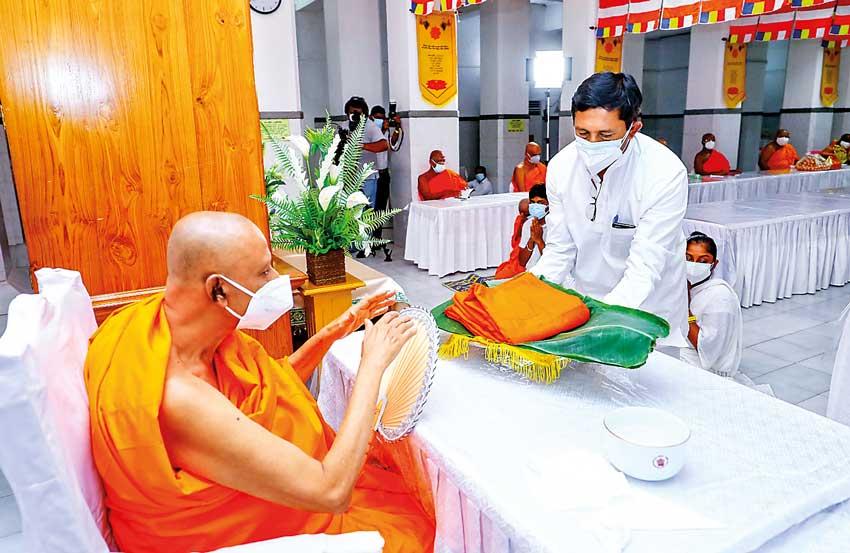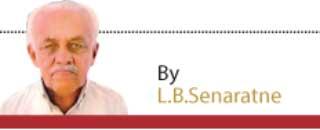Reply To:
Name - Reply Comment

The “ Katina Cheevaraya “ offered to the Senior member of the Maha Sangha to be decided as to whom it should be offered. It was received by the Anunauyake of Malwatta Maha Vihare Rajakeeya Panditha Venerable Niyangaoda Vijitha Siri on behalf of the congregation of monks.
 The conclusion of ‘Vap Poya’ marks the end of the retreat of the monks. The word ‘Retreat’ is more spoken in the Catholic sphere, but this word could also be used to define the retreat of the Buddhist monks during the period of Vas or the confinement of the monks to one place to meditate and also give the teachings of Buddha to the devotees, as to how they could lead a better life and attain eternal bliss.
The conclusion of ‘Vap Poya’ marks the end of the retreat of the monks. The word ‘Retreat’ is more spoken in the Catholic sphere, but this word could also be used to define the retreat of the Buddhist monks during the period of Vas or the confinement of the monks to one place to meditate and also give the teachings of Buddha to the devotees, as to how they could lead a better life and attain eternal bliss.
During the period of Buddha, who was once residing a Jetawanaramaya in Sharvasthipura, a group of monks visited him, deranged as it was the rainy season in India, usually from July to October. Buddha felt very sorry for the state of monks and he preached that during the rainy season it was better to reside in one place than go about the country to disperse their knowledge to the laymen as there was a sect who showed that the monks were trampling the grass or leaves which had wildlife and therefore they were committing a sin. To evade criticism the Buddha preached to the monks who visited him that they should confine themselves to their abodes.
The Buddha also advised them that they should have one additional robe than the two robes they are entitled to, other than the begging bowl. This then forms the core of the ‘Katina Cheevaraya’.
In the days of the Buddha the Katina Cheevaraya was stitched from the cloth that one finds in sites where dead bodies are wrapped. These are taken out washed and then cut and stitched to form a robe. But today the robe is often bought from shops which also sell the material for this attire. But some refer to buying white cloth and then offer it as a ‘Katina Cheevaraya’, which is then converted into a yellow robe by adding dyeing on the same day it is offered by the devotees.
There is a responsibility that is thrust on the monk who accepts the ‘Katina Cheevaraya’.
The devotees look forward to the period of offering the ‘Katina Cheevaraya’ as they consider that even touching this robe during the rituals brings merit that surpasses any other merit that they gain during their life in the world.
The offering of the Katina Cheevaraya at the Temple of the Tooth promoted the offering as a ceremony and is now a seasonal event which ends on Ill Poya day.
The Cheevaraya was stitched at the new wing of the Temple of the Tooth. Later the Cheevarya was dyed in the quadrangle of the Maligawa and offered to priests.
But the offering can be accepted only by one though many would have been in ‘Vas’ or retreat.
The offering of the ‘Katina Cheevaraya’ by devotees is to the maha Sangha, but they have no say as to who should receive the robe. After the offering is made to priest the congregation of monks present would decide upon whom it is entitled to. After the offering is accepted by a chosen monk a deep responsibility lies with him. The ‘Katina Cheevaraya’ should be worn as the third robe.
The monk who accepts the ‘Cheevaraya’ can leave his fixed abode only for a day and if he is not returning for the night he should inform his superiors or the Chief Dayakaya (Donor) of the Temple. But he cannot also be out for several days. There is a responsibility that is thrust on the monk who accepts the ‘Katina Cheevaraya’.
The devotees also have a responsibility to care for the monk or monks who have been invited to spend the ‘Vas’ season at their Temples. They should care for them and look after his or their needs. In return, the monks would call all devotees to listen or for a discourse in the teachings of the Buddha.
There are particular rituals associated with the Katina robe. If one Katina Cheevara is offered to a monk in a particular area it could not be offered to any other monk in the same area. Of course, this rule is now not adhered to by the devotees.
The end of the offering of the meritorious ‘Katina Cheevaraya’ ends on Ill Poya.
The devotees prepared themselves with meetings of the Temple Committees or the Dayaka Sabhas to prepare for the offering as they believe in the purity of the ‘Katina Cheevaraya’.
Even at the Sri Dalada Maligawa the same form is adopted for this offering, but it is much colourful and coordinated by the Diyawadana Nilame Pradeep Nilanga Dela.
The Katina Cheevaraya was brought from the Lady Blakes Aramaya at Katukela headed by Sil Mehinaya Ven. Kotmale Sudharma Meniya.
The Presence of devotees was confined to a few adhering to the present health guidelines.